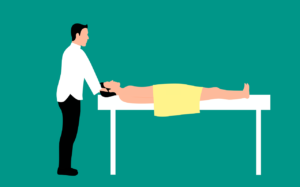
Are you constantly waking up with a stiff neck and intense pain? It could be attributed to your pillow. Neck pain from a bad pillow is a common issue that many people face, and it can significantly affect your daily life. But fret not, there are simple and effective ways to relieve that discomfort and get back to a good night’s sleep. In this article, we will share ten practical tips that can help alleviate neck pain caused by a bad pillow. So say goodbye to those sleepless nights and say hello to a pain-free morning!
Choosing the Right Pillow
Choosing the right pillow is essential for getting a good night’s sleep and waking up without any neck pain or discomfort. There are a few factors to consider when selecting a pillow, including your sleeping position, the materials used, the loft or height of the pillow, and any specialized pillows that may be beneficial. By taking these factors into account, you can find the perfect pillow that offers the right support and comfort for your specific needs.
Consider Your Sleeping Position
One of the first things to consider when choosing a pillow is your sleeping position. Different sleeping positions require different levels of support to ensure proper spinal alignment and prevent any unnecessary strain on your neck and shoulders.
If you are a back sleeper, you may benefit from a pillow with medium thickness to support the natural curve of your neck. Side sleepers, on the other hand, may need a firmer pillow to keep their head and neck properly aligned. Stomach sleepers generally require a softer, lower loft pillow to avoid excessive strain on the neck.
Try out Different Pillow Materials
Pillow materials can greatly affect your comfort and overall sleep quality. There are various pillow materials available, each with its own unique benefits. Memory foam pillows conform to the shape of your head and neck, providing personalized support and pressure relief. Buckwheat pillows, filled with buckwheat hulls, offer natural breathability, support, and can be adjusted to suit individual preferences. Water-filled pillows can be customized by adding or removing water to achieve the desired level of support. Try out different materials to find the one that suits you best.
Adjust the Pillow Loft
Pillow loft, also known as the height or thickness of the pillow, plays a crucial role in maintaining proper spinal alignment. The loft of your pillow should correspond to your sleeping position to prevent any strain on your neck and shoulders. Back sleepers generally require a medium loft pillow, while side sleepers may benefit from a higher loft pillow. Stomach sleepers need a low profile pillow to keep their neck aligned with the rest of the spine. Take the time to adjust the pillow loft until you find the perfect height that provides optimal comfort and support.
Consider Specialized Pillows
In addition to traditional pillows, there are also specialized pillows available that cater to specific needs. Cervical pillows, for example, are designed to support the natural curvature of the spine and provide targeted support for the head and neck. Contoured cervical pillows have a unique shape that cradles the neck and promotes proper alignment. Orthopedic cervical pillows are made with supportive materials and are ideal for individuals with chronic neck pain or conditions like cervical spondylosis. Consider specialized pillows if you have specific neck or spine-related issues.
Sleeping Positions and Pillow Support
Your sleeping position plays a crucial role in determining the type of pillow support you need to maintain proper spinal alignment and reduce the risk of neck pain.
Back Sleepers and Pillow Thickness
If you are a back sleeper, the thickness of your pillow is an important consideration. Back sleepers generally require a medium thickness pillow that can adequately support the natural curve of the neck. A pillow that is too thin may result in the head tilting back, straining the neck, while a pillow that is too thick can push the chin towards the chest, causing discomfort. Find a pillow with just the right thickness to ensure optimal support and comfort while sleeping on your back.
Side Sleepers and Pillow Firmness
Side sleepers need a pillow that provides firm support to keep the head and neck aligned with the spine. The pillow should be thick enough to fill the space between the ear and shoulder, ensuring proper spinal alignment. A firm pillow can help prevent the head from sinking too far into the mattress, which can strain the neck and lead to pain and discomfort. Look for a pillow that offers proper firmness to give side sleepers the support they need.
Stomach Sleepers and Pillow Softness
Stomach sleepers require the softest pillow of all sleeping positions. When sleeping on your stomach, it’s important to keep the neck in a neutral position to avoid straining the muscles and joints. A soft, low loft pillow can help achieve this by preventing the head from being raised too high and putting excessive pressure on the neck. Opt for a pillow that offers a comfortable softness for stomach sleepers to ensure a restful night’s sleep.

Pillow Height and Spinal Alignment
Maintaining proper spinal alignment is crucial for preventing neck pain and discomfort. The height of your pillow can greatly impact your spinal alignment, so it’s important to find the right balance.
Maintain Neutral Spine Alignment
When lying on your back, your pillow should support the natural curvature of your neck, keeping it aligned with the rest of your spine. If the pillow is too high, it can cause the neck to tilt forward, straining the muscles and joints. Conversely, if the pillow is too low, the neck may be unsupported, leading to discomfort. Find a pillow height that keeps your spine in neutral alignment to prevent unnecessary strain and ensure a comfortable sleep.
Ensure Proper Support for the Head and Neck
Along with maintaining neutral spine alignment, the pillow should also provide adequate support for the head and neck. The right pillow will allow your head to rest comfortably while keeping your neck supported and aligned. Without proper support, your neck may experience strain and tension, leading to pain and discomfort. Consider the thickness and firmness of your pillow to ensure proper support for your head and neck, allowing for a pain-free night of sleep.
Cervical Pillow Options
Cervical pillows are specifically designed to support the neck’s natural curve and help relieve neck pain. There are different types of cervical pillows available, each offering unique benefits.
Contoured Cervical Pillows
Contoured cervical pillows have a distinctive shape that follows the natural curve of the neck and provides targeted support. These pillows often feature a central depression, which cradles the head, and raised sides that support the neck. Contoured cervical pillows help maintain proper alignment and relieve pressure on the neck and shoulders. If you suffer from chronic neck pain or discomfort, a contoured cervical pillow may be an excellent option to consider.
Orthopedic Cervical Pillows
Orthopedic cervical pillows are designed to provide therapeutic support and comfort for individuals with neck pain or specific spinal conditions. These pillows are made from supportive materials that help alleviate pressure on the neck and promote proper spinal alignment. Orthopedic cervical pillows often have a unique shape with multiple levels of support to cater to different sleeping positions. If you have specific neck or spine-related issues, consult with a healthcare professional or consider an orthopedic cervical pillow for added support.

Pillow Shape and Neck Support
The shape of your pillow can greatly affect the level of neck support it provides. Different pillow shapes offer various benefits and cater to individual preferences.
Consider a Memory Foam Pillow
Memory foam pillows have gained popularity due to their ability to contour to the shape of your head and neck, offering personalized support. These pillows are designed to relieve pressure points and provide excellent neck support. The memory foam material conforms to the natural curves of the neck, promoting proper alignment and reducing the risk of neck pain. If you prefer a pillow that molds to your specific shape and provides customized support, a memory foam pillow may be the right choice for you.
Try a Buckwheat Pillow
Buckwheat pillows have been used for centuries and offer natural breathability, support, and adjustability. These pillows are filled with buckwheat hulls, which conform to the shape of your head and neck while ensuring proper airflow. Buckwheat pillows can be adjusted by adding or removing hulls to achieve the desired loft and firmness. If you prefer a pillow with natural materials that can be customized to your preferences, consider trying a buckwheat pillow for optimal neck support.
Consider a Water-Filled Pillow
Water-filled pillows are another option to consider for customizable neck support. These pillows have a pouch or chamber filled with water that can be adjusted to achieve the desired level of firmness and support. Water-filled pillows offer excellent contouring properties, conforming to the shape of your head and neck for optimal comfort. If you prefer a pillow that can be easily adjusted to suit your needs and preferences, a water-filled pillow may be worth considering.
Pillow Maintenance and Replacement
Proper pillow maintenance and replacement are essential for ensuring optimal comfort and support while preventing any potential health issues. Here are some tips to follow:
Clean Pillows Regularly
Regularly cleaning your pillows is crucial to remove any dirt, dust, allergens, or sweat that may accumulate over time. Most pillows can be machine washed, but always check the care instructions specific to your pillow. Additionally, consider using a pillow protector to keep your pillow clean and prolong its lifespan.
Replace Pillows Regularly
Even with proper maintenance, pillows should be replaced regularly to maintain optimal support and hygiene. Over time, pillows can lose their shape and firmness, leading to reduced support and comfort. As a general guideline, it is recommended to replace pillows every 1-2 years. If you notice signs of wear and tear, such as lumps or an uneven surface, it may be time to invest in a new pillow.

Improving Sleep Posture
Beyond choosing the right pillow, there are additional steps you can take to improve your sleep posture and reduce the risk of neck pain.
Use Additional Supports
If you find that your pillow alone is not providing sufficient support, consider using additional supports, such as a rolled-up towel or a small pillow, to fill any gaps and ensure proper alignment. These supports can be placed under the neck or between the knees, depending on your specific needs and comfort preferences.
Avoid Tucking Pillows Under the Neck
While it may be tempting to tuck a pillow under your neck for added support, this can actually lead to strain and discomfort. Tucking a pillow under the neck can disrupt the natural alignment of the spine, causing unnecessary pressure and potentially exacerbating neck pain. Instead, focus on finding a supportive pillow that provides adequate neck support without the need for additional props.
Physical Therapy and Neck Pain Relief
In some cases, neck pain may require additional intervention beyond simply choosing the right pillow. Physical therapy can be a valuable resource for neck pain relief and rehabilitation.
Perform Neck Exercises
Physical therapists can teach you specific exercises to strengthen the muscles in your neck and improve your range of motion. These exercises can help alleviate pain, restore flexibility, and improve overall neck health. It’s important to consult with a healthcare professional or physical therapist to ensure you’re performing the exercises correctly and safely.
Try Neck Stretches
Stretching can help relax tense muscles and improve flexibility in the neck and shoulders. Incorporating neck stretches into your daily routine can provide relief from neck pain and promote better posture. Some common neck stretches include neck rotations, lateral neck stretches, and chin tucks. It’s important to perform these stretches gently and without any pain. If you experience any discomfort, consult with a healthcare professional.
Seek Professional Help
If neck pain persists or worsens despite your best efforts, it may be time to seek professional help. A healthcare professional, such as a doctor, chiropractor, or physical therapist, can evaluate your specific situation, diagnose any underlying issues, and provide appropriate treatment options. They may recommend additional therapies, interventions, or further medical evaluation to address your neck pain effectively.
Heat and Cold Therapy
Heat and cold therapy are simple and effective methods for relieving neck pain and reducing inflammation.
Apply Heat for Muscle Relaxation
Heat therapy can help relax tight muscles in the neck and improve blood circulation, promoting healing and pain relief. You can apply heat to your neck using a heating pad, warm towel, or hot water bottle. Be sure to follow the manufacturer’s instructions and avoid excessive heat to prevent burns or skin damage. Apply heat for 15-20 minutes at a time, several times a day, as needed.
Use Cold Therapy for Inflammation
Cold therapy, also known as cryotherapy, can help reduce inflammation and numb the area, providing pain relief. You can apply cold therapy to your neck using an ice pack, a bag of frozen peas, or a cold towel. Wrap the cold object in a thin cloth to protect your skin, and apply it to the affected area for 10-15 minutes at a time, several times a day, as needed.
Massage and Self-Care Techniques
Massage can provide tremendous relief from neck pain and muscle tension. While professional massage therapy is ideal, there are also self-care techniques you can try at home.
Self-Massage Techniques for Neck Pain Relief
You can use your own hands to massage your neck and shoulders to relieve tension and promote relaxation. Start by gently massaging the sides of your neck, using circular motions with your fingertips. Gradually move down the neck and apply gentle pressure to any tense or sore areas. You can also use a tennis ball or foam roller to massage your neck and upper back. If self-massage techniques do not provide sufficient relief, consider seeking professional massage therapy.
Consider Professional Massage Therapy
Professional massage therapy can offer targeted relief and relaxation for neck pain. Massage therapists are trained in various techniques that can improve blood circulation, reduce muscle tension, and alleviate pain. They can focus on specific areas of concern and provide a tailored treatment plan to address your individual needs. If you are experiencing chronic neck pain, consider consulting with a licensed massage therapist to explore the benefits of professional massage therapy.
By following these tips and considering the various factors involved in choosing the right pillow, you can significantly reduce the risk of neck pain and achieve a restful night’s sleep. Remember to prioritize your comfort, support, and overall spinal alignment when selecting your pillow. If neck pain persists or worsens, consult with a healthcare professional to receive a proper diagnosis and explore additional treatment options. Your pillow should be your trusted companion in achieving restful sleep and maintaining good neck health.







